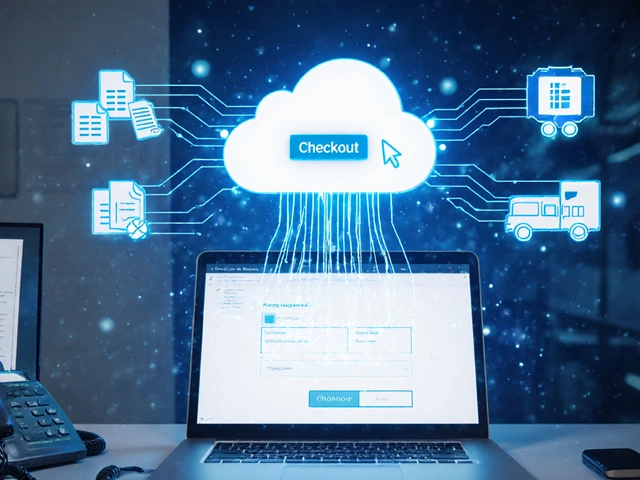Ever looked at those delivery trucks, endless warehouses, and thought, 'How much money does this all actually make?' You’re not alone. Lots of people assume logistics is a straightforward cash machine. But dig a little deeper, and the profits aren’t as obvious as you'd expect. Hidden costs pile up fast—fuel spikes, returns, last-mile headaches, inefficient routes, and lost inventory can wipe out what look like sweet margins on paper.
Now, the real secret weapon? Software. The best logistics players use digital tools to track every package, reroute deliveries in real-time, and even predict supply chain slowdowns before they happen. Companies ditching their manual spreadsheets and moving to automation are seeing profit margins jump 10-20% in just a couple of years. Not a magic trick—just tech finally catching up to the chaos of moving stuff from A to B.
So if you’re looking at logistics as a business, the money’s definitely there—but only for the ones moving fast and smart, not just fast. Let’s break down what actually makes this industry profitable, where the money disappears, and how software can be the game-changer you didn’t know you needed.
- What Does Profit in Logistics Really Mean?
- The Real Costs You Can't Ignore
- How Logistics Software Changes the Game
- Tips to Squeeze More Margin Out
- Where Most Companies Drop the Ball
- What the Future Holds for Logistics Profits
What Does Profit in Logistics Really Mean?
When people talk about logistics profits, they’re not just chatting about big revenue numbers or how many boxes you move. It’s all about how much you keep after every single cost gets subtracted—fuel, drivers, tech, insurance, returns, late fees, packaging, the whole deal. The tricky part? The list of expenses in logistics can get long fast.
Profitability in logistics usually means looking at net profit margins. In 2024, averages for logistics companies hovered between 4% and 7%. That means for every $100,000 moving through the system, companies keep at best $7,000 after costs. For comparison, the tech industry sometimes scoops up margins of 25% or more. So, every percent counts here.
Check out how these core numbers stack up for mid-sized logistics companies:
| Metric | Average Value (2024) |
|---|---|
| Gross Profit Margin | 12% - 18% |
| Net Profit Margin | 4% - 7% |
| Operating Costs (% of revenue) | 80% - 90% |
The biggest myth? That logistics is just about trucks and warehouses. Nope. It’s a balance of moving fast, staying super accurate, and squeezing every extra dollar from each shipment. A few cents shaved off a delivery adds up to serious profits at big volumes.
So, the main takeaway here: profit in logistics is a tight squeeze, and most of the game now is about using logistics profitability tools to cut waste, adapt to surprises, and get the most out of every run.
The Real Costs You Can't Ignore
Jumping into logistics, you might think it’s all about trucks, drivers, and a warehouse or two. But here’s the reality—profits get eaten up by costs that most folks don’t see coming. And those costs aren’t just about buying vehicles and paying people. They stack up across every mile, every delivery, and every mouse click.
Let's break down what actually hits the bottom line:
- Fuel: Prices bounce up and down, and one swing can wipe out weeks of profit. In 2024, average diesel prices hovered around $4.10 per gallon—up from $3.30 just three years earlier.
- Labor: Drivers, dispatchers, warehouse workers—wages went up by 8% in North America last year alone.
- Maintenance: Trucks don’t fix themselves. A single breakdown can mean $500 in repairs and thousands lost from missed shipments.
- Returns: With e-commerce exploding, return rates can hit 20% or more. Every return costs twice—once to the buyer and again to process it back in the warehouse.
- Insurance: Rates shot up 17% for commercial vehicles in 2024 thanks to more theft and accident claims.
- Warehousing: Shortage of space means warehouse rents jumped 14% last year, especially near big cities.
- Tech: Sure, software can save money, but setting it up takes time and cash—especially if you want real-time tracking and easy integration.
See what these add up to for a typical mid-sized logistics company?
| Cost Type | Average Annual Spend (USD) | % of Total Costs |
|---|---|---|
| Fuel | $2,100,000 | 27% |
| Labor | $3,300,000 | 42% |
| Maintenance | $600,000 | 8% |
| Insurance | $400,000 | 5% |
| Warehousing | $900,000 | 11% |
| Tech/Software | $350,000 | 4% |
| Other/Misc | $250,000 | 3% |
Notice that labor and fuel eat up around 70% of total expenses. That’s why companies are obsessed with efficiency and automation. Even saving a few bucks per mile with the right logistics profitability strategy makes a huge difference when you’re moving thousands of shipments every month.
The bottom line? You can’t just watch sales or invoices. You need to track and tackle every single cost, or your profit will vanish into thin air.
How Logistics Software Changes the Game
Ten years ago, logistics was a mess of phone calls, paper logs, and gut feelings. Now, software is running the show—tracking shipments, flagging bottlenecks, and even finding the cheapest fuel stops along the route. This isn’t just about looking modern; it’s about real dollars saved and headaches avoided.
The biggest win? Visibility. With solid logistics software, managers see exactly where every shipment is, who’s running late, and what needs to reroute to dodge bad weather or traffic. UPS shaved off 10 million gallons of fuel in a single year just by letting their route-optimization software do its thing. That’s real savings, not just in costs, but in time and stress, too.
Here’s where logistics software makes the most impact:
- Logistics profitability: Companies using real-time tracking can often cut inventory costs by 20% since they know what they have and where it is—no more over-ordering or scrambling to find stock.
- Automation: Software takes over the boring stuff, like billing, scheduling pickups, and sending delivery updates. That means fewer mistakes and less staff time wasted.
- Analytics: Want to know which truck costs you more in repairs? Or which route always ends up late? Good software gives you the data so you don’t rely on hunches.
- Customer trust: When you tell a customer, “Your order’s arriving at 8:52 a.m.,” and actually mean it, your reviews go up and so does repeat business.
One tip if you’re shopping for logistics software: don’t cheap out and go for a half-baked system. The best setups plug right into your other tools—like warehouse inventory and customer support—and keep everything in sync. You want updates in real-time, not after the fact. That’s how the companies at the top are keeping their edge and making serious money.

Tips to Squeeze More Margin Out
Want higher profits in logistics? You’ll need a sharp eye and the right toolkit. Chasing bigger margins is about getting rid of wasted time, cutting manual hassle, and not letting small leaks drain your income. Here’s how the top logistics pros pull off bigger gains, and some moves you can try right now.
- Logistics profitability starts with route optimization. Companies using smart route-planning cut delivery costs by up to 15%, according to a 2024 study by Shipwell. Software that accounts for traffic, order size, and fuel pricing can reroute drivers on the fly, keeping overtime and fuel use down.
- Automation isn’t a nice-to-have—it’s the difference between scraping by and leading the pack. Automating order entry and warehouse picking knocks down human error and saves hours every day. Firms using barcode scan systems report order accuracy rising by 40-60%.
- Don’t skip real-time inventory tracking. The average logistics operator with real-time tracking slashed lost or misplaced inventory by 30% in 2023, based on Flexe’s annual survey. Less lost stuff equals fewer reimbursements and less wasted hunting for product.
- Negotiate better deals with your vendors and carriers. Don’t just accept standard rates. In 2025, a survey by Freightos showed that shippers who revisited contracts annually managed to save 8% on average versus those who stuck with the same rates.
- Be brutal about analyzing delivery exceptions—late drops, lost items, or damaged packages. Fixing common root causes (like poor labeling or wrong address entry) can push delivery success rates above 98%.
Check out this table for a quick sense of how simple changes impact the bottom line:
| Strategy | Typical Cost Savings |
|---|---|
| Route Optimization | 10-15% |
| Order Automation | 30-50% |
| Real-Time Inventory Tracking | Up to 30% |
| Strong Vendor Negotiation | 5-10% |
| Reduced Delivery Exceptions | 2-7% more on-time deliveries |
If you stack just a few of these improvements together, profit margins that used to seem out of reach start looking a lot more realistic. It’s not rocket science—just the right moves and a steady focus on fixing what slows you down.
Where Most Companies Drop the Ball
Lots of logistics companies talk a big game about cutting costs, but most trip up on the same basic things. First up: data. Nearly half the industry still relies on spreadsheets or even paper to track shipments and inventory. A 2023 survey by Logistics Management magazine found that nearly 40% of mid-sized firms struggled with lost or delayed shipments because they're still stuck in manual tracking mode. Mistakes like these pile up fast, chipping away at already thin margins.
Another common trap is ignoring the small, hidden costs. Companies focus on big-ticket expenses like trucks and warehouses, but stuff like failed deliveries, repeat routes, waiting times at docks, and returns quietly eat away profits. Missed on-time rates can even trigger penalties with major clients, especially big retailers that grade you on every shipment. Stores like Walmart and Target charge 'OTIF' (On-Time In-Full) fines that can run thousands of dollars a month for just a few late or incomplete deliveries.
Employee training is another spot where companies get lax. Many skip proper onboarding or refreshers for drivers and warehouse staff. This leads to more damaged goods, slower turnaround, and mistakes that could have been prevented. Companies that structure monthly training or use digital checklists see way fewer errors on the ground.
Probably the biggest swing-and-miss? Delaying investment in the right logistics software. Sticking to old systems might feel cheaper up front, but long-term, it leads to missed orders, bad customer service, and aggravated shippers. When you add up lost business and wasted resources, the numbers make it clear: automation isn’t a luxury, it’s a survival tool.
- Upgrade old manual processes with digital tracking tools.
- Watch out for sneaky costs like delays, overtime, and inefficient routes.
- Seriously invest in training—trained staff make fewer costly mistakes.
- Review contracts with major customers so you don’t get hammered by late fees.
Getting these basics right creates a logistics operation that turns the daily grind into real profit, not just busywork.
What the Future Holds for Logistics Profits
If you look down the road, logistics isn’t slowing down—it’s actually revving up. E-commerce sales just keep climbing; in 2024, global e-commerce sales hit $6.3 trillion, and they’re expected to grow by about 9% annually for the next few years. More stuff to move means bigger opportunities—but also more pressure to do it faster and cheaper.
Logistics companies that invest in new tech are seeing the biggest profit boosts. For example, Gartner reported that organizations using advanced logistics profitability software cut operating costs by 12% and boosted order accuracy by up to 30%. This is huge, because every mistake—whether a lost box or a delayed pallet—can eat into margins fast.
Here’s what’s likely to shake up the market even more:
- Automation and AI: Robots in warehouses aren’t just hype. Some warehouses using fully automated picking systems have reported labor savings of up to 70%.
- Green Logistics: Customers are demanding cleaner operations. Companies that cut emissions might avoid carbon taxes, keeping more of what they earn.
- Real-Time Data: From tracking trucks on the road to scanning every package, instant information helps skip costly mistakes or delays.
- Flexible Delivery: Buyers want options—same-day, pickup points, anything to fit their schedule. Firms who can juggle all that without losing money win big.
Check out this quick comparison to see how profits shape up for different types of operators:
| Type of Operator | Average Net Profit Margin (2024) | Main Tech Advantage |
|---|---|---|
| Traditional 3PL (manual process) | 2-5% | Basic routing, limited tracking |
| Digital-first Logistics | 6-12% | End-to-end automation, dynamic route planning |
| Last-mile Startups | 4-8% | Urban micro-warehousing, crowdsourced fleets |
Bottom line: the game is changing, but profits are there for the companies willing to invest in tech, keep up with green trends, and stay flexible while everyone else is stuck in old routines.





